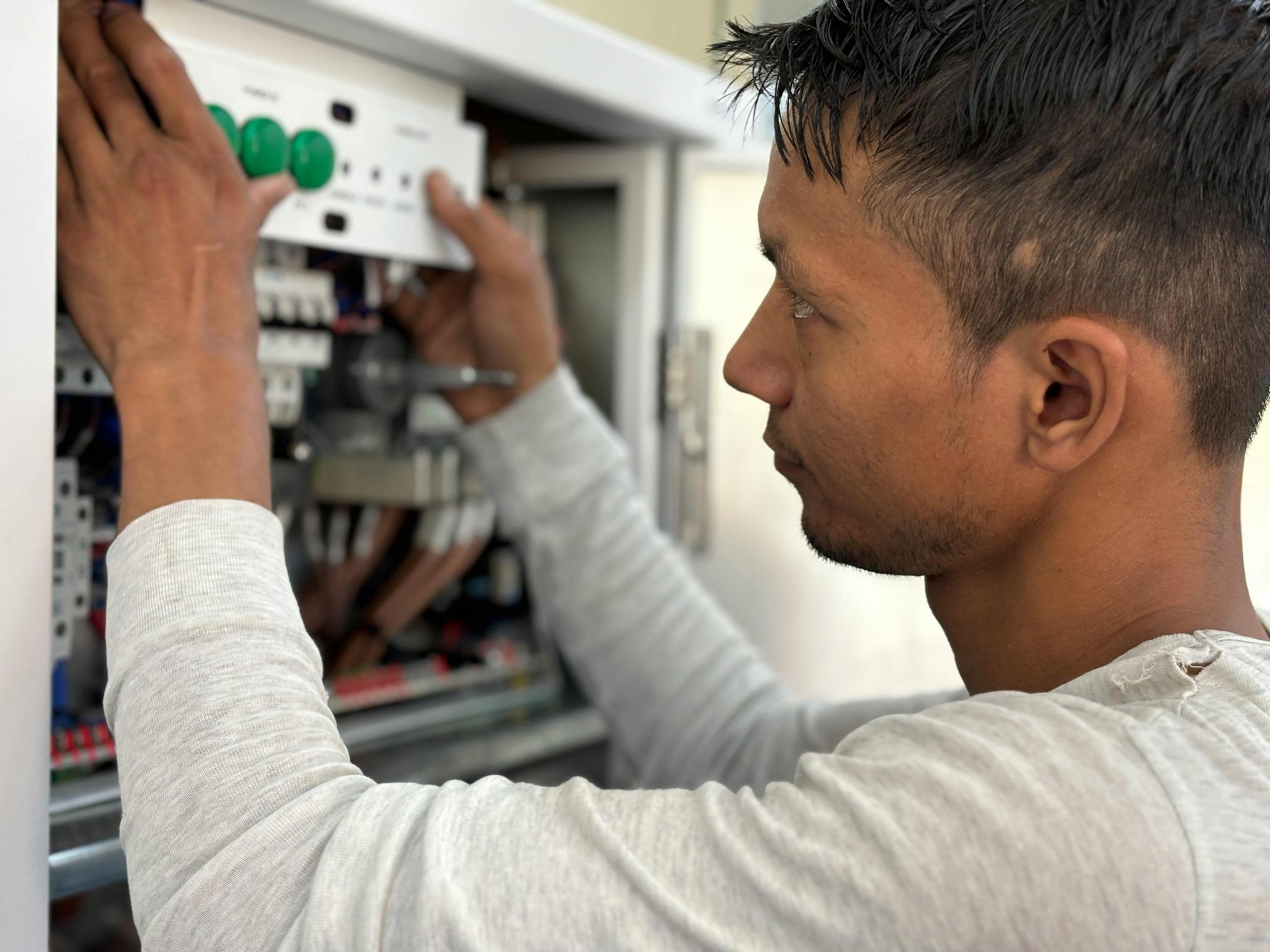How to Replace a Circuit Breaker: A Step-by-Step Guide
Circuit breakers are essential to home safety, protecting electrical circuits from overloading and preventing fires. Over time, breakers can wear out, causing electrical issues. Knowing how to replace a faulty breaker can restore electrical safety to your home. This guide will cover everything from identifying faulty breakers to replacing them safely.
Why You Might Need to Replace a Circuit Breaker
Before replacing a circuit breaker, it’s essential to understand why it might need replacement. Here are some of the main reasons:
- Frequent Tripping: If a breaker trips frequently despite normal electrical use, it may indicate a fault in the breaker itself.
- Visible Damage or Corrosion: Burn marks, rust, or corrosion around a breaker are indicators of wear.
- Breaker Won’t Reset: If a breaker won’t stay in the “on” position, even with no load, it may be defective.
- Burning Smell from Breaker Panel: A burning odor is a serious sign of overheating or melting in the panel.
Replacing a circuit breaker can be a manageable DIY task, but it’s essential to follow safety guidelines carefully.
Important Safety Tips Before You Begin
Working with electricity requires caution. Follow these essential safety tips to reduce risks when replacing a circuit breaker:
- Turn Off the Main Power: Always turn off the main breaker to cut power to the entire panel. This will prevent any electricity from flowing through the circuits.
- Use Insulated Tools: Insulated screwdrivers and pliers add an extra layer of safety against electrical shock.
- Wear Personal Protective Equipment (PPE): Gloves and goggles protect you from potential sparks and debris.
- Double-Check for Power: Use a multimeter to confirm that the panel is not receiving any electricity.
- Have a Partner Nearby: An extra set of eyes can be helpful in case of emergencies, so ask someone to stay with you while you work.
Tools and Materials You’ll Need
- Screwdriver (insulated handle)
- Pliers (insulated handle)
- Multimeter (to verify no power is flowing)
- Replacement circuit breaker (same brand, type, and amperage as the old one)
- Flashlight or headlamp (for visibility)
Now that you have your tools and safety measures in place, let’s go through the step-by-step process for replacing your circuit breaker.
Step 1: Identify the Faulty Circuit Breaker
Identifying the faulty breaker is crucial before starting the replacement process. This will help ensure you’re working on the correct circuit and minimize any guesswork. Here’s how to accurately locate the breaker in need of replacement:
- Label the Circuit: If your breaker panel doesn’t already have labels, now is a good time to mark them. Turn on specific lights, appliances, or devices in each room, and note which breaker controls each. This can be done by switching breakers one at a time until you determine which controls the targeted circuit. Write down the appliance or room controlled by each breaker on a piece of paper or directly on the breaker panel for future reference.
- Examine the Breaker Panel for Issues: Look for the breaker that either frequently trips or shows visible signs of wear, such as discoloration, burn marks, or corrosion. A breaker that won’t reset even after being turned off and back on could also be a sign of an internal fault. This breaker is the one you’ll need to replace.
Step 2: Turn Off the Main Breaker
Safety is paramount when dealing with electrical components, so turning off the main breaker before proceeding with any work on the panel is essential. Here’s how to do it:
- Locate the Main Breaker: In most residential breaker panels, the main breaker is positioned at the top. It’s typically larger and may even be labeled as “Main.” This breaker controls the power to the entire panel.
- Switch It Off: Firmly push the main breaker to the “off” position. Doing this cuts off the electricity to the entire breaker panel, ensuring that no power is flowing through any circuit.
- Verify Power is Off: To confirm there’s no power running through the panel, use a multimeter. Set the multimeter to test for voltage, and place the probes on the main terminals to ensure there’s no electrical current. Double-checking with a multimeter reduces the risk of accidental shock.
Step 3: Remove the Panel Cover
With the main power off, you’re now ready to access the circuit breaker panel’s interior components:
- Carefully Unscrew the Cover: Using an insulated screwdriver, begin loosening the screws holding the panel cover in place. Support the cover as you remove the last screw so it doesn’t fall.
- Use Caution: Even though the main power is off, avoid touching any exposed wires or busbars, as some residual electricity can remain in parts of the panel.
- Set the Cover Aside: Find a safe location to place the panel cover, away from the immediate work area. This will help prevent accidental damage to the cover or injury to anyone nearby.
Step 4: Remove the Faulty Breaker
With access to the inside of the panel, you’re ready to remove the faulty breaker carefully:
- Unclip the Breaker: Circuit breakers are usually designed to snap in and out of their slots. Carefully grab the faulty breaker and pull one end outward, away from the busbar, to release it from the slot. Gently wiggle it if it’s snug, but avoid excessive force.
- Disconnect the Wire: Use an insulated screwdriver to loosen the terminal screw holding the wire in place on the breaker. Once the screw is loose, gently pull the wire from the breaker’s terminal.
- Position the Wire Away from the Panel: Securely position the wire so it doesn’t come into contact with any live parts within the panel. It’s essential to keep it isolated to prevent accidental shocks.
Step 5: Install the New Circuit Breaker
Installing the new breaker requires precision to ensure it fits securely and makes proper contact with the busbar.
- Attach the Wire to the New Breaker: Insert the stripped end of the wire into the terminal on the new breaker. Tighten the terminal screw firmly, ensuring that there’s no exposed copper beyond the terminal. Properly secured wiring reduces the risk of arcing or overheating.
- Snap the Breaker into Place: Align the new breaker with its designated slot in the panel. Push it down firmly until it snaps into place and connects securely with the busbar. The breaker should fit snugly without any visible gaps or wobbling.
- Inspect the Installation: Check that the breaker is firmly seated and that all connections are tight. Loose connections can lead to poor performance or potential electrical hazards.
Step 6: Replace the Panel Cover
With the new breaker in place, it’s time to reassemble the panel:
- Align the Panel Cover: Position the cover over the breaker panel, ensuring that all switches align correctly with their respective slots in the cover.
- Screw in the Cover: Using your screwdriver, secure the panel cover by tightening the screws. Avoid over-tightening, as this can strip the screws or damage the cover.
Step 7: Turn On the Main Breaker and Test
With everything reassembled, you’re now ready to turn the power back on and test the new breaker:
- Switch On the Main Breaker: Flip the main breaker to the “on” position, restoring power to the panel. Take note of any unusual sounds or smells, which could indicate an issue.
- Test the New Breaker: Switch on the new breaker to see if it controls the circuit correctly. Turn on the lights or appliances on that circuit to confirm they’re receiving power. If everything works smoothly, you’ve successfully replaced the breaker.
- Observe for Proper Function: Monitor the breaker for a few minutes to ensure it doesn’t trip immediately and that everything operates as expected.
Troubleshooting Issues

After replacing the breaker, you may encounter some issues. Here’s how to handle them:
- Breaker Trips Immediately: If the new breaker trips right away, there could be a short circuit in the wiring or appliance on that circuit. Turn off the breaker and consult an electrician.
- Power Fluctuations: If the power supply is inconsistent, there might be loose connections or an issue with the main panel. Call a professional for further inspection.
- Burning Smell or Sparks: If you notice a burning smell or sparks, switch off the main breaker and contact an electrician immediately.
Frequently Asked Questions (FAQ)
Q1: Can I Replace a Circuit Breaker Myself?
Yes, but only if you feel comfortable and confident with electrical work. Always follow strict safety guidelines, and if unsure, consult a licensed electrician.
Q2: How Much Does a Circuit Breaker Replacement Cost?
A circuit breaker itself costs between $10 and $50, depending on the amperage and brand. Hiring a professional to replace it can cost around $150 to $300.
Q3: What Size Circuit Breaker Should I Use?
Always replace a circuit breaker with one of the same size (amperage). Installing a breaker with a higher amperage than the circuit is rated for can lead to overheating and fires.
Q4: How Can I Tell if My Circuit Breaker Needs Replacement?
Frequent tripping, difficulty resetting, visible damage, or a burning smell can all indicate a faulty breaker. If in doubt, consult an electrician.
Final Thoughts
Replacing a circuit breaker can be a straightforward DIY project, but safety should be your primary concern. Following these steps carefully will help you complete the replacement safely and effectively. Remember, electricity is dangerous, and there’s no shame in calling a professional if you feel uncertain at any stage of the process. With the right tools, precautions, and instructions, you’ll have your electrical system running smoothly in no time.

